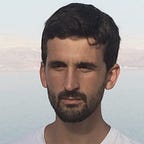Portable science
I often go back to Enrique Vila-Mata’s 1985 short novel Brief history of portable literature. I like all Vila-Matas, but this is one of my favourites, although probably not his best. I enjoy its blend of absurdity and erudition, I suppose. “Portable literature” refers to the act of travelling with a baggage-like desk where the traveler (a writer) carries all of his writing stuff, including their own ouvre. When opened, the desk can be used on trains, cafes, etc., setting a miniaturised but complete studio anywhere. Marcel Duchamp is the best-known introducer of this idea. Vila-Matas, in his book, equips a range of writers (mainly poets and outcasts) with such a portable desk. Soon, the practitioners of portable literature set up an eccentric group called the Shandy Secret Society. The Shandies have various rules, including behaving like kids, staying unmarried, having an extreme sexuality, an imperative need for innovation, and “a disinterest in grand statements, a tireless nomadism, a fraught coexistence with doppelgängers, a sympathy for negritude, and the cultivation of the art of insolence”.
The Shandy Secret Society started in 1924, inspired by a fictitious city named Port Actif, dreamed by Duchamp himself (it is quite clearly a play of words: portatif is the French for portable). Duchamp and three other friends travel to Port Actif, which is set at the mouth of the Niger river. They do not find much there, but they nonetheless plant the seed of the society and, back in Paris, they do the inaugural meeting at the legendary bookshop Shakespeare & Co. Thereafter, a stream of characters (some real, some imagined) appear in the various happenings of the Shandies, first in Paris and then in Vienna, in Prague, and all across Europe. We see Jorge Luis Borges, Francis Scott Fitzgerald, Salvador Dalí, Walter Benjamin and Robert Walser, among others, as well as lesser known artists. We also see the Odradek, a creature from a Kafka novella that threatens the creativity of the authors and their peace of mind.
For the most part, the escapades of the Shandies are nonsense and laughable. But it is also true that the itinerant writers are after a difficult goal: to achieve a literature that is as modular and minimal as possible (as portable as possible). The Shandies do significant efforts to get rid of distractions and avoid the Odradeks and other creatures that chase them. The struggle of the Shandies is to miniaturise objects and language so that they can own as much as possible and still continue to travel light. They abandon the aspiration that every other writer has — to write a “total book: a book of books encompassing all others”, since such a book cannot possibly be portable and is therefore delusional. The Shandies are, after all, a bunch of self-aware and insecure individuals trying to master the art of living, which for a writer necessarily involves the art of reading and the art of writing, combined with the art of being free.
We have to travel all the time to get Ersilia going. I haven’t had a stable apartment for the last two years. I am not necessarily proud of this fact, nor I find it idyllic, but this is how things have unfolded. Every time I go back to the Brief history of portable literature, I wonder if there is such a thing as “portable science”, and whether I am a practitioner of it. It is tempting to answer “yes”: all of my equipment consists of a laptop computer and a second portable screen that helps me a lot during my coding sessions. This is no different to Duchamp’s portable desk. A priority of Ersilia is to conduct scientific research in-country (meaning in the Global South). At the end of June, we will be at the University of Buea, in Cameroon. After three weeks, we will visit the Centre for Infectious Disease Research in Zambia (CIDRZ). From there, we will shortly return to Spain and then back to the Centre for Drug Discovery and Development (H3D), in Cape Town, South Africa, for a couple of months. We must touch the data, the infrastructure, and the people, before doing any science. I don’t think the remote model works for us, at least not at project commencement. What really works is the portable model. “Remote” and “portable” are very different, almost antonymic terms. If you remember the metaphor of Ersilia, the Invisible City, this is what it is all about: getting settled, building a network of relationships, and then leave without actually dismantling much. Certainly not dismantling the network, which will always remain.
I guess the question becomes: should we expect similar outcomes from a portable scientist than from someone who works in a conventional (static) laboratory? Or, should portable science be more fragmented, more distilled, shorter, or even simpler than static science? Also, are there unbearable distractions in the life of a portable scientist? Do they fear something like an Odradek, a creature that sabotages their focus time and hampers insightful thoughts? If this is the case (I think it is), what is the role of a portable scientist in the grand scheme of things? The Shandies lived portable lifes and therefore produced portable literature, which was valued in entirely different metrics than traditional books. The portable scientist most likely gives away senior authorship in scientific publications, since they are never in a project end-to-end. What would be a good metric or index for a portable scientist? Is there a career path for someone who hops from project to project simply because most scientific studies are too large, not portable, too demanding, and way too heave to carry around?
